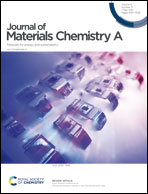Tetrahexahedral PdRh nanocrystals with tunable composition as a highly efficient electrocatalyst for ethylene glycol oxidation†
Abstract
Optimization of the structure and composition is critical to obtain excellent electrocatalytic performance of palladium-based electrocatalysts, which have received extensive attention in the past few decades. However, the synthesis of PdRh nanocrystals (NCs) enclosed by high-index facets with different compositions is still rarely reported. Herein, alloy tetrahexahedral (THH) PdRh NCs enclosed by {11 4 0} facets with tunable composition were prepared for the first time by an electrochemical square-wave potential method. The as-prepared PdRh NCs exhibit high catalytic activity for ethylene glycol (EG) electrooxidation. The catalytic activity highly depends on the alloy composition, and THH Pd86.9Rh13.1 NCs exhibit the highest catalytic activity, which is 2.0 and 11.1 times higher than that of THH Pd NCs and commercial Pd/C, respectively. In situ FTIR spectroscopic studies of THH Pd86.9Rh13.1 NCs and THH Pd NCs revealed that the introduction of Rh can enhance the capability of cleaving the C–C bond. This study indicates that the synergetic effect of high-index facets with the alloy electronic structure is promising for the preparation of high performance electrocatalysts.



 Please wait while we load your content...
Please wait while we load your content...